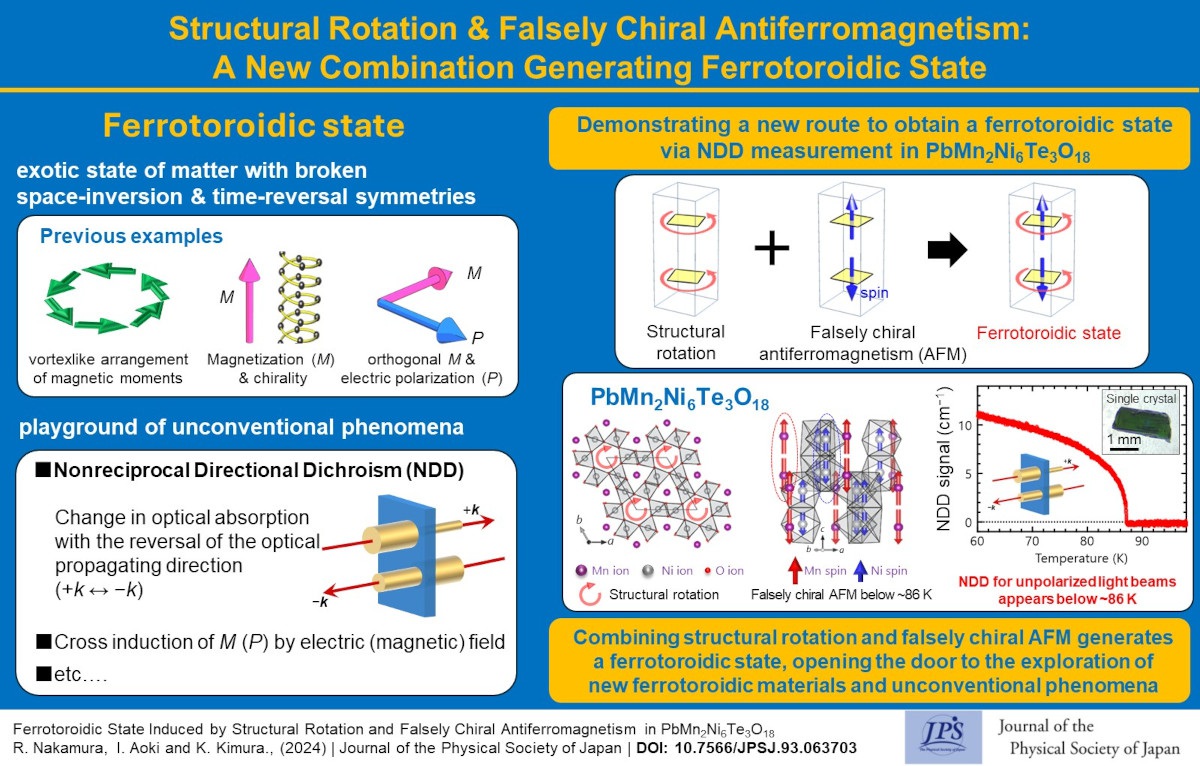Structural Rotation and Falsely Chiral Antiferromagnetism: A New Combination Generating Ferrotoroidic State
© The Physical Society of Japan
This article is on
Ferrotoroidic State Induced by Structural Rotation and Falsely Chiral Antiferromagnetism in PbMn2Ni6Te3O18
(JPSJ Editors' Choice)
J. Phys. Soc. Jpn.
93,
063703
(2024)
.
The ferrotoroidic state, an exotic state of matter with broken space inversion and time-reversal symmetries, was achieved by combining structural rotation and falsely chiral antiferromagnetism in PbMn2Ni6Te3O18.

The ferrotoroidic state is an exotic state of matter characterized by the breaking of both space-inversion and time-reversal symmetries because of a particular arrangement of magnetic moments (spins) and/or constituent atoms (ions). This multiple symmetry breaking can lead to various unconventional physical phenomena. A representative example is the linear magnetoelectric (ME) effect, that is, the linear induction of electric polarization or magnetization by an applied magnetic or electric field, respectively. This effect allows magnetism to be manipulated using an applied electric field. In addition, when a light beam propagates in a ferrotoroidic material, the absorption coefficients of the two counter-propagating light beams can differ. This phenomenon is called nonreciprocal directional dichroism (NDD) and has potential applications in novel optical devices. Furthermore, the nonreciprocal propagation of (quasi-)particles and current-induced magnetization can also occur in ferrotoroidic materials. Therefore, the search for new ferrotoroidic materials and the mechanisms that generate ferrotoroidic states are of great interest.
In this study, the authors investigated the optical properties of PbMn2Ni6Te3O18, which consists of a rotational arrangement of structural units (i.e., structural rotation) and exhibits antiferromagnetic order below 86 K. The antiferromagnetic order in this material is regarded as “falsely” chiral because a mirror-image pair of the spin arrangement cannot be superimposed on each other (i.e., apparently chiral); however, unlike a chiral object, it can be related by a time-reversal operation. The authors successfully observed NDD signals in the antiferromagnetic state by measuring the optical absorption coefficient of counterpropagating unpolarized light beams. NDD for unpolarized light beams occurs only when a material is in a ferrotoroidic state. Therefore, the present results demonstrate that the ferrotoroidic state is induced by structural rotation and falsely chiral antiferromagnetism in PbMn2Ni6Te3O18.
In recent decades, the ferrotoroidic state has been intensively studied as a source of interesting physical phenomena. Several mechanisms generating the ferrotoroidic state have been revealed, including the emergence of a torus-shaped arrangement of magnetic moments, a combination of chirality and magnetization, and mutually orthogonal electric polarization and magnetization. The combination of structural rotation and falsely chiral antiferromagnetism differs from conventional mechanisms. Therefore, the present work provides a new route for achieving a ferrotoroidic state, stimulating further exploration of ferrotoroidic materials and their exotic physical properties.
(Written by K. Kimura on behalf of all the authors)
Ferrotoroidic State Induced by Structural Rotation and Falsely Chiral Antiferromagnetism in PbMn2Ni6Te3O18
(JPSJ Editors' Choice)
J. Phys. Soc. Jpn.
93,
063703
(2024)
.
Share this topic
Fields
Related Articles
-
Higher-Order Topological Phases in Magnetic Materials with Breathing Pyrochlore Structures
Electronic structure and electrical properties of surfaces and nanostructures
Magnetic properties in condensed matter
Mathematical methods, classical and quantum physics, relativity, gravitation, numerical simulation, computational modeling
2025-4-7
A simple example of a higher-order topological phase, in which the symmetry decreases step-by-step from the bulk to the corner, is realized in a magnetic system with a pyrochlore structure and is characterized by a series of quantized Berry phases defined for the bulk, surface, and edge.
-
Existence of Chiral Soliton Lattices (CSLs) in Chiral Helimagnet Yb(Ni1-xCux)3Al9
Magnetic properties in condensed matter
2025-4-1
Our study examines the magnetic structure of the monoaxial chiral helimagnet Yb(Ni1-xCux)3Al9, providing first direct evidence of the formation of chiral soliton lattice state.
-
Understanding Pressure-Induced Superconductivity in CrAs and MnP
Magnetic properties in condensed matter
2025-3-10
This study reviews existing research on the pressure-induced variation of magnetic properties of transition metal mono-pnictides like CrAS, MnP, and others, aiming to understand the unconventional superconductivity observed in CrAs and MnP.
-
Symmetry and AI: Building the Future of Physics Simulations
Magnetic properties in condensed matter
Measurement, instrumentation, and techniques
2025-2-18
Generative artificial intelligence (AI) has gained considerable attention in scientific fields. By embedding physical symmetry into AI before training, we created a faster and lighter model. Scaling improves the accuracy and unlocks the potential of physics research and applications.
-
Triangular Lattice Magnet GdGa2: Spin Cycloids and Skyrmions
Cross-disciplinary physics and related areas of science and technology
Electronic transport in condensed matter
Magnetic properties in condensed matter
2025-2-3
Careful measurements were conducted on the hexagonal magnet GdGa2 to reveal the experimental signatures of ultrasmall spin cycloids and of a potential Néel-type skyrmion lattice phase induced by a magnetic field.




